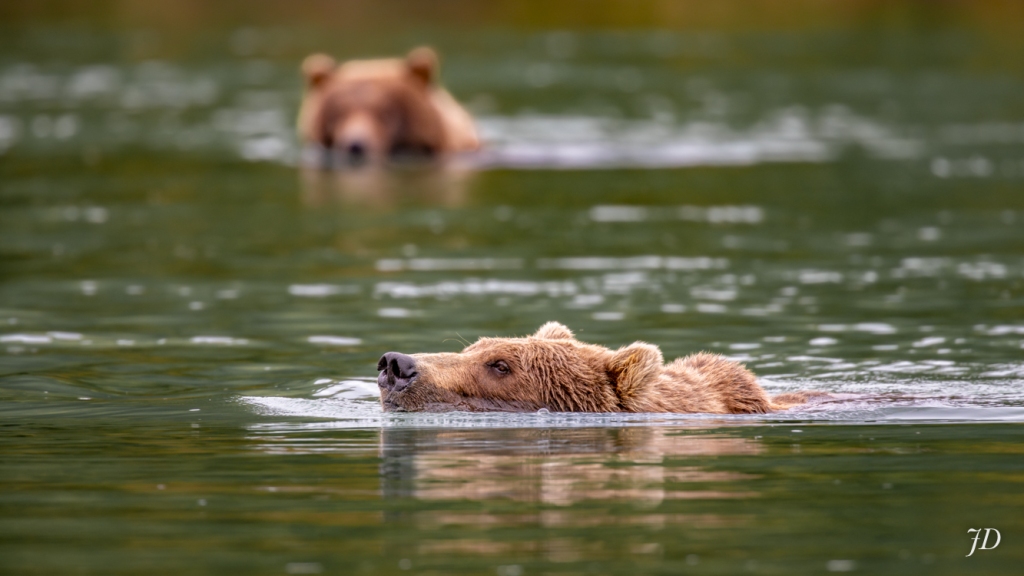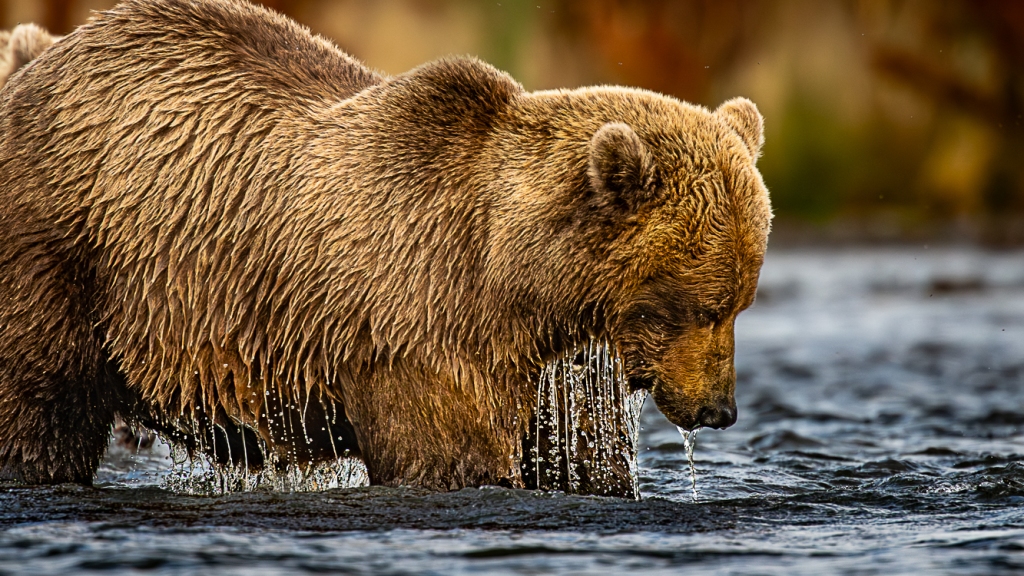
Coastal Brown Bears crossing the Chignik River, September 22, 2018
Why did the Brown Bear cross the river?
Happy Friday, everyone!


I went to the woods because I wished to live deliberately, to front only the essential facts of life, and see if I could not learn what it had to teach, and not, when I came to die, discover that I had not lived. Henry Thoreau, Walden

A second bear is just barely visible in the upper left of this photograph of a healthy sow that has trapped a spawning Sockeye Salmon in her forepaws beneath the water. Anytime the salmon are running from July through November, bears can be expected along the river and lake.

During the several years we fished the water at Paradise Bend (our name for an expansive area of tidally influenced braided runs and gravelled, vegetated islands), we only encountered other anglers on one occasion. Their guide had them casting in the wrong places – unproductive water unlikely to hold salmon. In due time their casts became listless, eventually gave way to billed caps lifted and head-scratching, and then to searching glances at each and beseeching looks toward the guide. They left fishless, and that was the only time we encountered anglers on “our” pool.
Paradise is a very special place, often beautifully lit by morning light, frequented by some of the world’s largest Brown Bears, traversed by moose, mink, fox, otter and wolf, shorelines decorated in season by magenta fireweed, sunflower-like arnica, marsh marigold and a dozen other showy blooms. At any time of year the water is free of ice you might hear the ratchety call of a kingfisher, and all summer long there are the songs of thrushes, sparrows and warblers to cheer the day. Gulls and eagles scavenge the islands when the fish are in, and in spring the wide, weedy shallows load up with Tundra Swans and hundreds of ducks. The ducks, particularly Mallards and Green-winged Teal, return en force in fall, and it was near Paradise that I encountered a brilliantly marked male Spotted Redshanks – a rare stray from Asia.
Tucked back in a bend off the main channel where boats never ran, it was easy to lose oneself during a morning at Paradise. Schools of newly arriving Coho pushing up tidal-bore-like bulges of smooth water as they arrived in the main pool were a thrill, and the fishing could be agreeably challenging in the clear, shallow water where we could watch the fish come to our flies. At the take, we would strip-set and then brace for long runs punctuated by cartwheeling acrobatics. There were more productive pools on the river, but none more enjoyable to fish.
Maybe even more satisfying than these periods of activity were the times in between, the water temporarily empty of salmon, the big sky, the vast landscape, bird song, rushing water and quiet… a place to let thoughts find their own way and perhaps to visit with a friend or love from the past who, for whatever reason, is now absent. There are a lot of reasons to take down a fly rod from its wall pegs and go to the water. There is the fishing, of course… but there are times when the promise of uninterrupted thought is the more compelling motivation.

Autumn Char
Perhaps there is no species of fish more stunningly marked than a char in spawning colors. Regardless of their size or the particular species (there are dozens scattered across the Northern Hemisphere), the beauty of a fall char offers a special reward for a fly-fishing outing to the cold, clean rivers, streams and brooks they inhabit. The term char is thought to derive from the old Irish ceara or cera, which refers to the blood red coloration sported by some char.
The specimen in the above photo is of the species Salvelinus malma, Dolly Varden, caught on September 25, 2016 on a local creek. While many char inhabit only fresh water, others, such as the 18-inch male in this picture, spend part of their lifecycle at sea. This fish had migrated to a small stream where he was fattening up on salmon eggs prior to his own spawning event. While the char of the Chigniks don’t attain the massive size of certain populations elsewhere (30 pounders have been recorded), their spirit as a game fish when taken on a light fly or tenkara outfit and their striking coloration make char of any species among our favorites. And by the way, if you’ve never treated yourself to a meal of char, check for farmed Arctic Char where you purchase fish. Unlike farmed salmon, which we strongly advise avoiding, farmed char are a sustainable, ecologically smart choice. Served whole or filleted, the meat is sumptuous. (Olympus Tough TG-3, 1/320 at f/32, ISO 100)
If you’d like to read more about cooking and fishing for char…

Cherry Coho
In the early days of my Pennsylvania youth, I thought that a salmon was a salmon was a salmon. That’s generally the way they were presented back then – in texts, on restaurant menus, in other contexts. Salmon. Gradually, (in large part thanks to outdoor sporting magazines given to me by my grandfather), I came to understand that there are seven species worldwide, and that’s not including the many genetically distinct races within those species.
As fascinating as this genetic plasticity is, the changes salmon undergo throughout their life cycle are equally captivating. On October 9, 2020, the Coho in the above photograph was no longer feeding. Her stomach and digestive track had atrophied to almost nothing. The salmon intercepted Barbra’s streamer for reasons fly anglers have long puzzled over. Meanwhile, day by day her roe sacks were swelling, her scales were being absorbed into skin which was becoming thicker and more leathery, the tip of her jaw was developing a distinctive hook known as a kype, and the silvery sheen along her flanks had begun taking on a pallet of color worthy of fine art. (Nikon D800, 105mm f/2.8, 1/50, ISO 250)